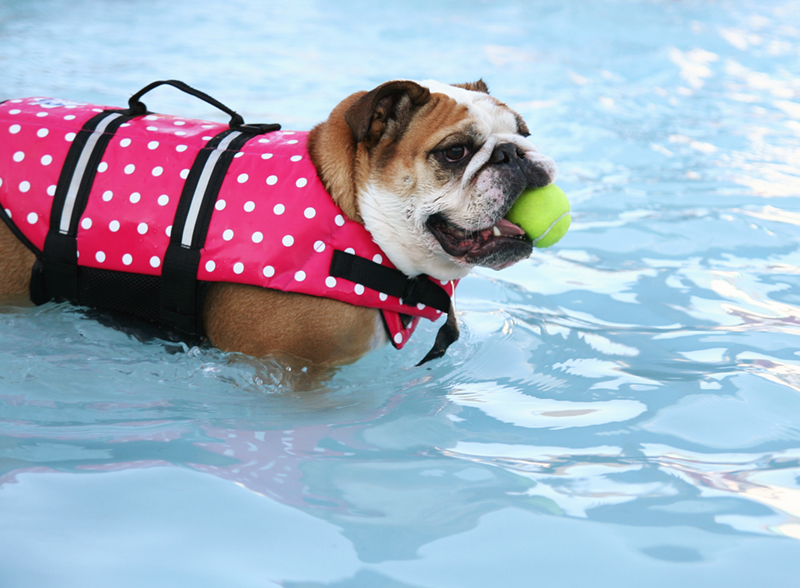With record high temperatures all over the country this summer, people are trying everything to keep cool.
Whether your water activities are focused on backyard pool barbecues, picnics on the beach, or time spent on a boat, chances are that the family dog will be included in many of these activities. Needless to say, it’s really important to keep your canine companion safe around water.
There is a common misconception that because there is a swimming style called the ‘dog paddle,’ that all dogs are strong swimmers. Nothing could be further from the truth.
Sink or swim?
Your dog’s aquatic abilities will largely depend on its body structure. Breeds that are long-limbed, muscular, and strong – like golden retrievers, Labradors, Newfoundlands, standard poodles, water spaniels, English and Irish setters, Chesapeake Bay retrievers, and Portuguese water dogs – are good swimmers and also known to enjoy water.
On the other hand, short, stocky breeds, such as bulldogs and pugs, and pooches with short little legs, like dachshunds and basset hounds, are going to struggle to stay afloat.
Troubled waters
It’s equally important to remember that just like children, some dogs are scared of water. Know your dog’s level of comfort in water.
If she has never been in water before, it’s a good idea to slowly introduce her to a swimming pool and ensure that she knows where the steps are in the shallow end so she can learn to exit on her own. A ramp, such as the Scamper Ramp, placed permanently in a pool will give dogs a chance to get out themselves or stay safer until someone assists.
Dogs should never be left unattended poolside. This is particularly important around pools that are above ground and not easy for a dog to exit unassisted.
S.O.S.
There are excellent flotation devices for dogs of all shapes and sizes, such as the Fun Fish life jacket. It has dual handles so it’s easy to quickly grab your pooch and take charge of a situation. It also has a front float section that goes under the chin to keep a dog’s head out of the water.

Whether you are poolside, on a boat, or even at the beach, it’s a good idea to ensure your dog is wearing a flotation device at all times.
Furthermore, never throw a dog into a pool “for fun.” Also, discourage children from throwing a ball or Frisbee into water for a dog to retrieve unless there is adult supervision. Kids are often having so much fun that they are unaware that a canine companion is in trouble in the water.
Skin deep
Whether it’s a saltwater pool or a chlorinated one, be sure to shower off your dog (and possibly even give a quick shampoo) to ensure that the coat doesn’t retain any salt or chemicals, which can cause itchiness and possibly lead to a troublesome skin irritation. The same applies if your dog has been in ocean, river, or lake water.
A dog’s skin is sun sensitive, too, and they are equally susceptible to skin cancer. There are special pet-friendly sunscreens, which should be applied to light and pink-skinned areas of the body – don’t forget the nose!
Creature comforts
Again, whether you are poolside, on a boat, or at the beach, be sure that your dog has somewhere comfortable to lie and relax that is off hot surfaces. Camping cots with a canopy or a cooling mat are transportable and can be set up anywhere.
In hot weather, pets can dehydrate quickly. So it’s important to ensure a large bowl of water is accessible at all times. Adding ice cubes will keep it colder for longer. Special bowls like FrostyBowlz contain a special gel core than can be frozen separately and keep the bowl’s contents cold for hours.
Dry as a bone
Excessive panting and appearing listless are common first signs of dehydration, along with a dry nose, gums, and mouth.
Also, the skin begins to show a lack of elasticity. You can do the “skin test” by pinching a little skin between your thumb and forefinger on your dog’s back. When you release it, it should pop back into place immediately. If it doesn’t, take your pet to a cooler environment right away.
If your dog is badly dehydrated, introduce fluids slowly. Better still, start off by letting your dog lick ice. Drinking too quickly may cause vomiting.
Have fun in the sun, but keep safety in mind for you and your loved ones – including your furry friend.
Related:
